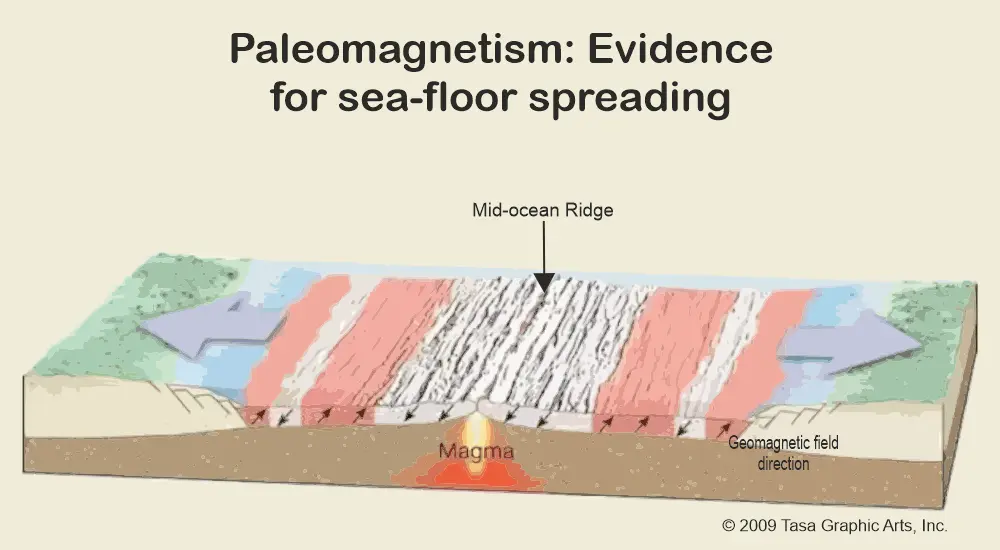Palaeomagnetism is a unique key to unlock the geological history of the Earth. Paleomagnetic dating is a method used to examine the ancient magnetic records preserved in rocks, offering glimpse into the Earth’s magnetic field over time. As rocks form, magnetic minerals align with the prevailing magnetic field, effectively freezing a snapshot of Earth’s polarity. By studying these magnetic imprints, scientists can determine the age of rocks and even track the movement of continents through time. Paleo magnetism not only helps in understanding the past positions of landmasses but also contributes to our knowledge of plate tectonics and the dynamic nature of Earth’s surface.
1. What is Palaeomagnetism?
(A) The study of ancient, magnetized rocks
(B) The study of fossilized remains of animals
(C) The study of ancient climate patterns
(D) The study of ancient plant species
(A) The study of ancient, magnetized rocks
Explanation: Palaeomagnetism is the study of ancient, magnetized rocks. It helps scientists understand the Earth’s past magnetic field and the movement of continents over geological time scales by analysing the magnetic properties of rocks.
2. What property of certain rocks makes them suitable for paleomagnetic studies?
(A) Their colour
(B) Their texture
(C) Their magnetic alignment
(D) Their chemical composition
(C) Their magnetic alignment
Explanation: Rocks suitable for paleomagnetic studies possess magnetic minerals that align themselves with Earth’s magnetic field at the time of their formation. This alignment can be preserved over geological time periods, providing valuable information about past magnetic conditions.
3. What causes rocks to become magnetized?
(A) Intense pressure
(B) Volcanic activity
(C) Exposure to sunlight
(D) Alignment with Earth’s magnetic field
(D) Alignment with Earth’s magnetic field
Explanation: Rocks become magnetized when magnetic minerals within them align with Earth’s magnetic field at the time of their formation. This alignment creates a permanent magnetization in the rocks.
4. What term describes the process by which rocks acquire a permanent magnetization aligned with Earth’s magnetic field at the time of their formation?
(A) Remanence
(B) Reversal
(C) Magnetization
(D) Alignment
(A) Remanence
Explanation: Remanence refers to the residual magnetization acquired by rocks during their formation, preserving the orientation of Earth’s magnetic field at the time of their formation.
5. What is the name of the phenomenon where Earth’s magnetic field periodically reverses direction?
(A) Paleomagnetic flip
(B) Magnetic declination
(C) Geomagnetic reversal
(D) Magnetic anomaly
(C) Geomagnetic reversal
Explanation: Geomagnetic reversal is the phenomenon where the Earth’s magnetic field undergoes a complete reversal in polarity, causing the magnetic north and south poles to switch positions.
6. Which type of rocks are commonly used in paleomagnetic studies due to their ability to preserve ancient magnetic information?
(A) Sedimentary rocks
(B) Igneous rocks
(C) Metamorphic rocks
(D) Organic rocks
(B) Igneous rocks
Explanation: Igneous rocks, such as basalts and volcanic lavas, are commonly used in paleomagnetic studies because they often contain magnetic minerals that align with Earth’s magnetic field during solidification and preserve this alignment over time.
7. What term describes the difference in direction between the magnetic north pole and the geographic north pole at a specific location?
(A) Magnetic inclination
(B) Magnetic declination
(C) Magnetic anomaly
(D) Magnetic reversal
(B) Magnetic declination
Explanation: Magnetic declination is the angular difference between the direction of true north (geographic north) and magnetic north at a specific location on the Earth’s surface.
8. What is the name of the instrument used to measure the magnetic properties of rocks in paleomagnetic studies?
(A) Magnetoscope
(B) Magnetometer
(C) Magnetograph
(D) Magnifier
(B) Magnetometer
Explanation: A magnetometer is the instrument used to measure the magnetic properties of rocks in paleomagnetic studies. It can detect the strength and direction of magnetic fields.
9. In which layer of the Earth’s interior does palaeomagnetism provide important information about past magnetic field changes?
(A) Crust
(B) Mantle
(C) Outer core
(D) Inner core
(A) Crust
Explanation: Paleomagnetism provides important information about past magnetic field changes primarily in the Earth’s crust, where rocks record the history of Earth’s magnetic field.
10. How does palaeomagnetism contribute to our understanding of plate tectonics?
(A) By providing evidence of past continental drift
(B) By measuring the rate of seafloor spreading
(C) By tracking the movement of magnetic poles
(D) By dating the formation of oceanic crust
(A) By providing evidence of past continental drift
Explanation: Paleomagnetism provides evidence of past continental drift by showing that magnetic minerals in rocks preserve the orientation of Earth’s magnetic field at the time of their formation, allowing scientists to reconstruct the movement of continents over geological time scales.
11. What is the term for the study of changes in the Earth’s magnetic field over time?
(A) Paleontology
(B) Geochronology
(C) Paleomagnetism
(D) Petrology
(C) Paleomagnetism
Explanation: Paleomagnetism specifically focuses on the study of changes in the Earth’s magnetic field over time, utilizing magnetic properties preserved in rocks and sediments.
12. Which type of rocks often preserves the best record of Earth’s ancient magnetic field?
(A) Sedimentary rocks
(B) Metamorphic rocks
(C) Igneous rocks
(D) Organic rocks
(C) Igneous rocks
Explanation: Igneous rocks, formed from solidification of magma or lava, often preserve the best record of Earth’s ancient magnetic field due to the alignment of magnetic minerals during their cooling process.
13. What is the primary mineral responsible for recording Earth’s magnetic field in rocks?
(A) Quartz
(B) Calcite
(C) Magnetite
(D) Feldspar
(C) Magnetite
Explanation: Magnetite is the primary mineral responsible for recording Earth’s magnetic field in rocks due to its strong magnetic properties and common occurrence in igneous rocks.
14. What does the term “Paleo intensity” refer to in Palaeomagnetism?
(A) The direction of Earth’s magnetic field in the past
(B) The strength of Earth’s magnetic field in the past
(C) The age of rocks based on magnetic properties
(D) The rate of magnetic pole reversals
(B) The strength of Earth’s magnetic field in the past
Explanation: Paleo intensity refers to the measurement of the strength of Earth’s magnetic field in the past, providing insights into variations in geomagnetic intensity over geological time scales.
15. Which of the following is a common method used to date rocks in paleomagnetic studies?
(A) Radiocarbon dating
(B) Potassium-argon dating
(C) Thermoluminescence dating
(D) Paleointensity dating
(B) Potassium-argon dating
Explanation: Potassium-argon dating is a common method used to date rocks in paleomagnetic studies, particularly in igneous rocks, by measuring the decay of radioactive potassium isotopes.










